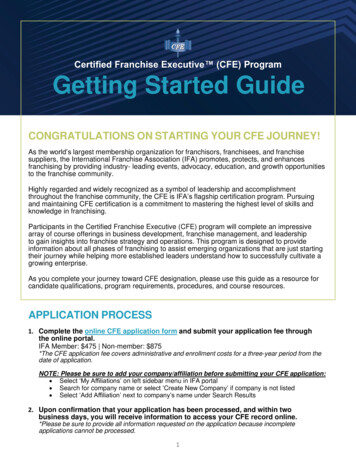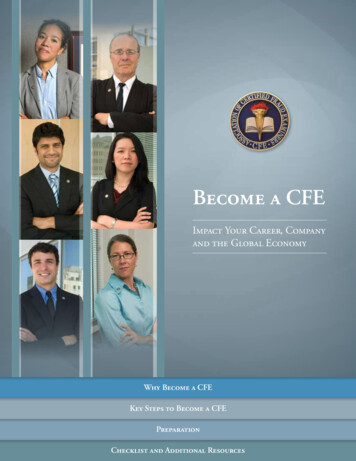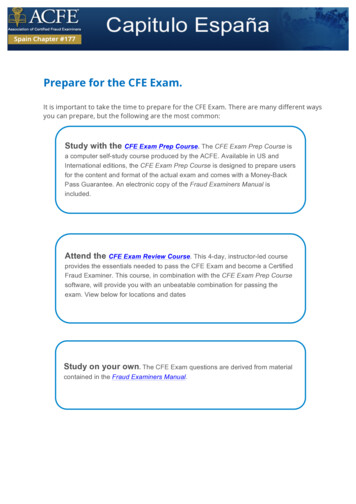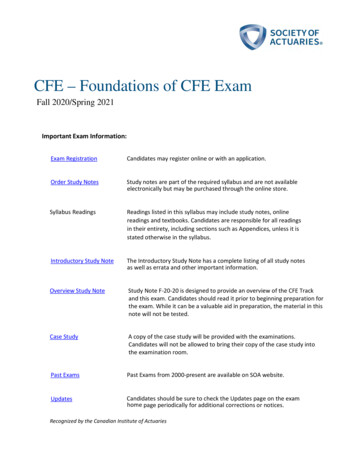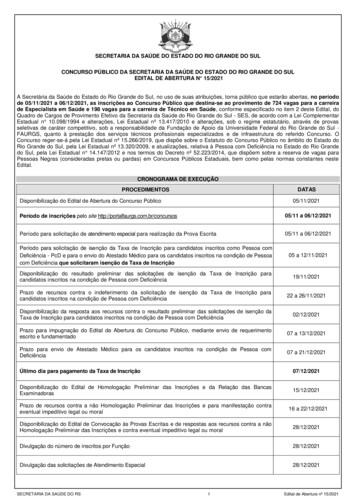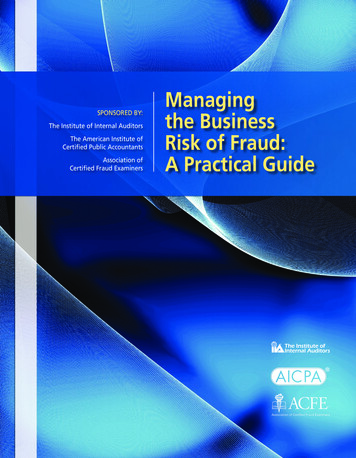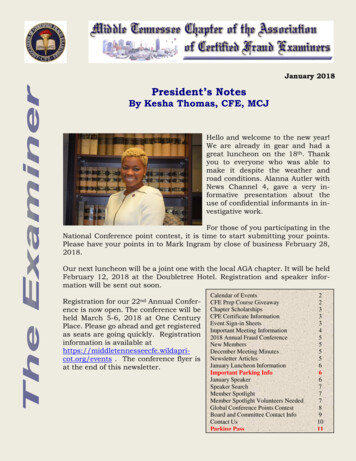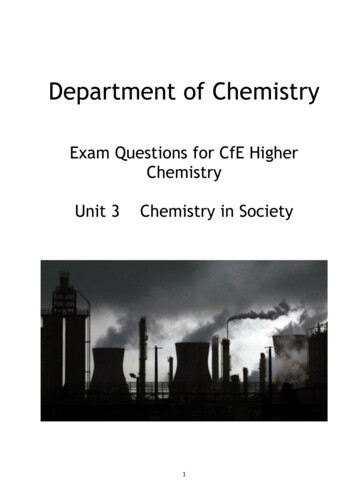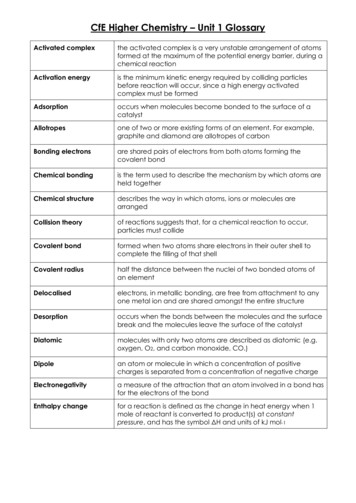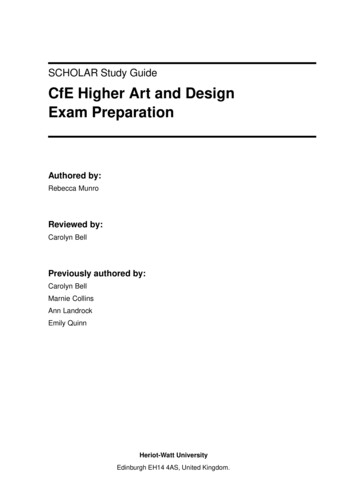
Transcription
SCHOLAR Study GuideCfE Higher Art and DesignExam PreparationAuthored by:Rebecca MunroReviewed by:Carolyn BellPreviously authored by:Carolyn BellMarnie CollinsAnn LandrockEmily QuinnHeriot-Watt UniversityEdinburgh EH14 4AS, United Kingdom.
First published 2016 by Heriot-Watt University.This edition published in 2016 by Heriot-Watt University SCHOLAR.Copyright 2016 SCHOLAR Forum.Members of the SCHOLAR Forum may reproduce this publication in whole or in part foreducational purposes within their establishment providing that no profit accrues at any stage,Any other use of the materials is governed by the general copyright statement that follows.All rights reserved. No part of this publication may be reproduced, stored in a retrieval systemor transmitted in any form or by any means, without written permission from the publisher.Heriot-Watt University accepts no responsibility or liability whatsoever with regard to theinformation contained in this study guide.Distributed by the SCHOLAR Forum.SCHOLAR Study Guide Exam Preparation: CfE Higher Art and Design1. CfE Higher Art and Design Course Code: C704 76ISBN 978-1-911057-10-9Print Production and Fulfilment in UK by Print Trail www.printtrail.com
AcknowledgementsThanks are due to the members of Heriot-Watt University's SCHOLAR team who planned andcreated these materials, and to the many colleagues who reviewed the content.We would like to acknowledge the assistance of the education authorities, colleges, teachersand students who contributed to the SCHOLAR programme and who evaluated these materials.Grateful acknowledgement is made for permission to use the following material in theSCHOLAR programme:The Scottish Qualifications Authority for permission to use Past Papers assessments.The Scottish Government for financial support.The content of this Study Guide is aligned to the Scottish Qualifications Authority (SQA)curriculum.All brand names, product names, logos and related devices are used for identification purposesonly and are trademarks, registered trademarks or service marks of their respective holders.
iContents1 Introduction to the written paper1.1 Introduction . . . . . . . . . . . . . . . . . . . . . . . . . . . . . . . .1.2 Artistic themes . . . . . . . . . . . . . . . . . . . . . . . . . . . . . .1.3 Section 1: Expressive art studies . . . . . . . . . . . . . . . . . . . .1.4 Section 1: Questions 1 and 2 . . . . . . . . . . . . . . . . . . . . . .1.5 Section 1: Question 3 and 4 . . . . . . . . . . . . . . . . . . . . . . .1.6 Movements in art . . . . . . . . . . . . . . . . . . . . . . . . . . . . .1.7 Visual art: Research and study . . . . . . . . . . . . . . . . . . . . .1.8 Helpful worksheets: Researching art movements, artists and artwork1.9 Summary . . . . . . . . . . . . . . . . . . . . . . . . . . . . . . . . .12278891219212 How to prepare for the written paper: Question 1 and 22.1 Art studies: Introduction . . . . . . . . . . . . . . . .2.2 Questions 1 and 2 example: The natural environment2.3 Questions 1 and 2 example: Figure composition . . .2.4 Practice questions 1 and 2: Worksheet tasks . . . . .2.5 Analysing artworks . . . . . . . . . . . . . . . . . . .2.6 Summary . . . . . . . . . . . . . . . . . . . . . . . .23242428313637.3 How to prepare for the written paper: Question 3 and 43.1 Art studies: Introduction . . . . . . . . . . . . . . . .3.2 Question 3 and 4 example . . . . . . . . . . . . . . .3.3 Question 3 and 4 exemplar answer . . . . . . . . . .3.4 Summary . . . . . . . . . . . . . . . . . . . . . . . .39404043474 How to prepare for the written paper: Question 5 and 64.1 Design studies: Introduction . . . . . . . . . . . . . .4.2 Question 5 and 6 example . . . . . . . . . . . . . . .4.3 Question 5 and 6 exemplar answer . . . . . . . . . .4.4 Summary . . . . . . . . . . . . . . . . . . . . . . . .49505054555 How to prepare for the written paper: Question 7 and 85.1 Design studies: Introduction . . . . . . . . . . . . . . . . . . . . . . . .5.2 Choosing a designer to study and design studies written paper . . . .5.3 Summary . . . . . . . . . . . . . . . . . . . . . . . . . . . . . . . . . .57585861Glossary62Answers to questions and activities1Introduction to the written paper . . . . . . . . . . . . . . . . . . . . . .6464
iiCONTENTS5How to prepare for the written paper: Question 7 and 8. . . . . . . .65 H ERIOT-WATT U NIVERSITY
1Topic 1Introduction to the written paperContents1.1Introduction . . . . . . . . . . . . . . . . . . . . . . . . . . . . . . . . . . . . .21.21.3Artistic themes . . . . . . . . . . . . . . . . . . . . . . . . . . . . . . . . . . .Section 1: Expressive art studies . . . . . . . . . . . . . . . . . . . . . . . . .271.41.5Section 1: Questions 1 and 2 . . . . . . . . . . . . . . . . . . . . . . . . . . .Section 1: Question 3 and 4 . . . . . . . . . . . . . . . . . . . . . . . . . . . .881.61.7Movements in art . . . . . . . . . . . . . . . . . . . . . . . . . . . . . . . . . .Visual art: Research and study . . . . . . . . . . . . . . . . . . . . . . . . . .9121.81.9Helpful worksheets: Researching art movements, artists and artwork . . . . .Summary . . . . . . . . . . . . . . . . . . . . . . . . . . . . . . . . . . . . . .1921Learning objectivesBy the end of this topic, you should: be able to understand clearly the format of the written paper; have developed knowledge and skills required to answer questions 1 and 2 of the'expressive art paper'; have developed knowledge and skills required to answer questions 3 and 4 of the'expressive art paper'; have understanding of what is meant by the term: Art movement; have understanding of how to produce personal research material about artmovements/artists and their work.
2TOPIC 1. INTRODUCTION TO THE WRITTEN PAPER1.1IntroductionThe CfE Higher written question paper: An overviewThe question paper will assess your knowledge and understanding of art and designwork and practice, and the social and cultural contexts that influence it.In the question paper, you will need to: critically analyse and evaluate the work of artists and designers, showingawareness of the visual elements, design issues and/or functional impact of thework; analyse and evaluate how artists and designers have used and combinedmaterials, techniques and/or technology for visual impact and/or functional effect; demonstrate in-depth understanding of art and design practice and work and thesocial and cultural contexts that influenced it.About the written paper You will have 2 hours to respond to the question paper. Complete two full questions from section 1. Question 1 or 2 parts (a) and (b),from a choice of two questions in the Expressive Art Studies section of the paperand question 3 or 4 parts (a) and (b) which are essay type questions. This whole first section of the paper is worth 30 marks in total.AND Complete two full question from section 2. Question 5 or 6 parts (a) and (b)from a choice of two questions in the Design Studies section of the paper andquestion 7 or 8 parts (a) and (b) which are essay type questions. This whole second section of the paper is worth 30 marks in total. The full paper is worth 60 marks.1.2Artistic themesQuestions 1 and 2 of the Expressive Art paper. Section 1 will cover any of the followingmajor themes: Portraiture: This is the artistic representation of a person. It can be a painting,sculpture or photograph. The intention is to capture the essence, personality andexpression of the sitter. A portrait usually conveys the sitter looking directly at theartist creating the image and this helps the viewer to engage with the subject. Figure composition: This may be sculpture, collage, photography or a painting.Figure composition focuses on human interaction in a specific place at a specific H ERIOT-WATT U NIVERSITY
TOPIC 1. INTRODUCTION TO THE WRITTEN PAPER3time. There is usually a setting or background within the composition which setsthe scene. There may be an underlying theme such as religion, war, leisureor historical events. An artist may have used figure composition to documentscenarios throughout history. Still life: A still life is a painting or other work of art which consists of one or moreinanimate objects arranged and positioned in such a way as to form a compositionwhich is inspiring to work from. When most people think of a still life they usuallyenvisage one composed of items such as fruit, flowers or dishes. A still life,however, can consist of any inanimate object. Natural environment: This is an artist’s response to land or seascape. Theartwork is a depiction of natural scenery where the visual elements are arrangedin a logical composition. Historically landscapes were used as a backdrop inscenes depicting historical or religious events. Landscapes can also show howman has had an impact on nature and often depict scenes of agriculture, farmingand industry. Built environment: Artists studying the built environment study cities, townsor well-known buildings. Historically the artworks normally depicted a realisticview rather than an imagined one but early 20th century representations startedto become much more abstract through the use of vivid colour and playfulcomposition. Fantasy and imagination: Fantasy art comes from the imagination more thanfrom direct observation of the real world. Like the word implies, it can be especiallyvisionary, unreal, fantastic, and dreamlike or nightmarish. The surrealist artmovement was most closely linked with this theme, though many prominent artiststhroughout history to the present day and across different cultures have portrayedimaginary scenes through various visual art forms.Therefore, in the written exam you will need to be prepared to answer any of the abovesubject areas.Artistic themesMatch the image to the artistic theme. For each question decide which discipline isappropriate from the given list. Fantasy and imagination Still life Portraiture Natural environment Figure composition Built environment H ERIOT-WATT U NIVERSITYGo online
4TOPIC 1. INTRODUCTION TO THE WRITTEN PAPERQ1:Match the image to the artistic theme.Fantasy and imagination, still life, portraiture, natural environment, figure composition,built environment.Q2:Match the image to the artistic theme.Fantasy and imagination, still life, portraiture, natural environment, figure composition,built environment. H ERIOT-WATT U NIVERSITY
TOPIC 1. INTRODUCTION TO THE WRITTEN PAPERQ3:Match the image to the artistic theme.Fantasy and imagination, still life, portraiture, natural environment, figure composition,built environment.Q4:Match the image to the artistic theme.Fantasy and imagination, still life, portraiture, natural environment, figure composition,built environment. H ERIOT-WATT U NIVERSITY5
6TOPIC 1. INTRODUCTION TO THE WRITTEN PAPERQ5:Match the image to the artistic theme.Fantasy and imagination, still life, portraiture, natural environment, figure composition,built environment.Q6:Match the image to the artistic theme.Fantasy and imagination, still life, portraiture, natural environment, figure composition,built environment. H ERIOT-WATT U NIVERSITY
TOPIC 1. INTRODUCTION TO THE WRITTEN PAPERResearch artistic themesResearch different artistic themes online or at the library and in your sketch book, collectthree other images of different artworks for each of the six artistic themes. Remember toconsider three-dimensional art work as well as two-dimensional in your selection. Showthis to your teacher or tutor when you are complete.1.3Section 1: Expressive art studiesThe Expressive Art Studies is a component part of the Art and Design Studies unitwithin the Higher Art and Design course. The unit will examine art practice throughinvestigation and discussion of one or a number of artists or an art movement in eithera historical and contemporary context or both of these.This unit focuses on investigating, gathering information and discussing a significantartist(s) or art movement, their work, relevant social issues, influences and the periodor art movement that they worked or work within. It is also important to establish anycontribution that the artist(s) may have made to the development of the visual arts in acontemporary or historical sense.The work produced should present relevant factual information, specialist terminologyand clear personal judgements and opinions.Working through the unit and completing the topics will help to prepare students for thewritten examination and can (but not essential) relate to and inform the developmentof the practical expressive activity. For this reason the context of the art study shouldfollow one of the six major themes studied by students following the Higher Art andDesign course. Still life Portraiture Figure composition Natural environment Built environment Fantasy and imaginationThis unit in the course will deal with the theme of still life for exemplification purposes. H ERIOT-WATT U NIVERSITY7
8TOPIC 1. INTRODUCTION TO THE WRITTEN PAPER1.4Section 1: Questions 1 and 2Key pointIn the exam spend approximately 20 minutes on this part of the question paper.Expressive Art Studies: Question 1 and 2Question 1 and 2 are worth 10 marks each.You are only asked to answer one of these:Each question will be divided into 2 parts:Part (a) focuses mostly on description. The question will ask you to describe individualpoints about specific visual elements or design issues in response to the image of visualart/design work. This part is worth 6 marks. These questions will assess your ability to respond to an image and to analyse theartist’s or designer’s use of specific elements within the work, using appropriatedescriptive and analytical art and design vocabulary.Part (b) focuses on analysis/justification of explanations. The question will ask you todiscuss/analyse combined points in response to the visual art or design work and makejustified comments about it. This part is worth 4 marks. You will also be asked to identify the effect of the specific elements and explaintheir collective contribution to the work as a whole whilst justifying your answer.Remember you will need to answer both (a) and (b) parts of either question 1 or 2 insection 1 - Expressive Art Studies and then both (a) and (b) parts in question 5 or 6 insection 2 - Design Studies.1.5Section 1: Question 3 and 4Expressive Art Studies: Question 3 and 4 Question 3 and question 4 are worth 20 marks each. Again, you are asked toanswer just one of these questions. Candidates will be expected to select and discuss examples of art and designwork they have studied throughout the course. There is an (a) and (b) part to thequestion. The (a) part of the question will specifically ask the candidate to discuss particularaspects of the art/design work e.g. composition, techniques, media, scale,methods of production, target audience etc. worth 10 marks The (b) part of the question will specifically ask the candidate to discuss theinfluence of social, cultural and/or other factors on the art/design work(s)chosen.Worth 10 marks H ERIOT-WATT U NIVERSITY
TOPIC 1. INTRODUCTION TO THE WRITTEN PAPER Candidate responses can be based on discussing any genre of work (2D and/or3D) from any time period. You will be asked to demonstrate breadth and depth of knowledge andunderstanding about artist’s, designer’s, their work, practice and the contexts thatinfluenced it as well as in-depth and reasoned responses.You can tackle this question in a number of ways: by referring to a single artist or designer and one or more examples of their work.OR 1.6alternatively, by discussing one example of art or design works from each ofseveral different artists, designers, movement.Movements in artA movement in art refers to a trend or a group of artists who agree on common principlesand produce work influenced by a common philosophy during a specific period of time.There may be a similarity in the techniques, methods, approaches or attitudes employedby the artists within the movement. Some movements in art overlap and there seems tobe no exact beginning or end to them, others are very distinct and the artists belongingto them are interested in new ideas, looking to the future rather than the past for stimulusfor their work.One movement can be short lived while others can last for a decade or more.Movements change as artists develop their philosophy and style of work. Movements inart are influenced by many factors such as developments in technology, materials, andpolitical and social events.The list of art movements and artists available for study is unlimited. In the 'ExpressiveArt Studies' written paper, where the term 'artist' is used it should be interpreted in itsbroadest sense. This includes possible study of painting, printmaking, photography,sculpture, installation, animation, film and video etc. It is acceptable for candidates torefer to groups of artists rather than individuals, eg art movements or artists who workin pairs or groups such as Surrealism, Jake and Dinos Chapman, the Boyle family.The choice that you make will depend on the resources available to you. Discuss yourchoice with your teacher, tutor or lecturer before embarking on the visual art study.The following movements are in chronological order, this will help to place eachmovement in a time line and help give an understanding of how western visual art hasdeveloped from 1750 to the present day. H ERIOT-WATT U NIVERSITY9
10TOPIC 1. INTRODUCTION TO THE WRITTEN PAPERKey pointRemember you can study any artist(s) from any time period.Period/MovementDatesKey ArtistsNeo-Classicismmid 1700 toearly1800Jacques-Louise David (1748-1825) FrenchJean-Auguste Ingres (1780-1867) Frenchlate1800-1850Caspar David Friedrich (1774-1840)GermanTheodore Gericault (1791-1824) FrenchEugene Delacroix (1798-1863) FrenchJohn Constable (1776-1837) EnglishWilliam Turner (1775-1851) English1848-early 1900William Holman Hunt (1827-1910) EnglishJohn Everett Millais (1829-1896) EnglishDante Gabriel Rossetti (1828-1896) EnglishEdward Burne-Jones (1833-1898) Englishmid to late 1900Gustave Courbet (1819-1877) FrenchHonore Daumier (1808-1879) FrenchEdouard Manet (1832-1883) FrenchHenri Fantin-Latour (1836-1904) FrenchJames Tissot (1836-1902) FrenchImpressionism1860-1900Camille Pissarro (1830-1903) FrenchEdgar Degas (1834-1917) FrenchClaude Monet (1840-1926) FrenchPierre-August Renoir (1841-1919) FrenchPost-Impressionism1880s-early1900Paul Cezanne (1839-1906) FrenchPaul Gauguin (1848-1903) FrenchVincent van Gogh (1853-1890) DutchSymbolism1880sPaul Gauguin (1848-1903) FrenchGustav Klimt (1862-19180) AustrianEdvard Munch 91863-1944) NorwegianModernismFirst half of 20thcenturyNote: A broad movement that incorporatedall avante-garde isms who rejectednaturalism and an academic approach toart.Fauvism1905-1908Henri Matisse (1886-1954) FrenchAndre Derain (1880) FrenchMaurice de Vlaminck (1876-1958) FrenchExpressionism1905-1920Emile Nolde (1867-1956) GermanWassily Kandinsky (1866-1944) RussianFranz Marc (1880-1916) German1907-1914Pablo Picasso (1881-1973) SpanishGeorge Braque (1882-1963) FrenchJuan Gris (1887-1927) SpanishRomanticismPre-RaphaelitesRealismCubism H ERIOT-WATT U NIVERSITY
TOPIC 1. INTRODUCTION TO THE WRITTEN PAPERPeriod/MovementDatesKey ArtistsFuturism1909-1916Giacomo Balla (1871-1958) ItalianCarlo Carra (1881-1966) ItalianSuprematism1915-1918Kasimir Malevich (1878-1935) RussianEl Lissitzky (1890-1947) Russian1919-1930Vladimir Tatlin (1885-1953) RussianLaszlo Moholy-Nagy (1895-1946)HungarianKurt Shwitters (1887-1948) German1924-1940sSalvador Dali (1904-1966) SpanishMax Ernst (1891-1976) GermanRene Magritte (1898-1967) Belgian1945-1960Willem De Kooning (1904-1997) Dutch-bornAmericanJackson Pollock (1912-1956) AmericanMark Rothko (1903-1970) Russian-bornAmericanmid 1950s 1970sPeter Blake (b. 1932) EnglishPatrick Caulfield (1936-2005) EnglishRichard Hamilton (b. 1922) EnglishDavid Hockney (b. 1937) EnglishAllan Jones (b. 1937) EnglishRoy Lichtenstein (1923-1997) AmericanAndy Warhol (1928-1987) AmericanTom Wesselmann (1931-2004) American1960sSol Lewitt (b. 1928) AmericanJoseph Beuys (1921-1986) GermanMarcel Duchamp (1887-1968) French-bornAmerican1960sCarl Andre (b.1935) AmericanEva Hess (1936-1970) GermanRobert Rauschenberg (b.1925) AmericanLate 1980sTracy Emin (b.1963) BritishDamien Hirst (b.1965) BritishRon Mueck (b.1958) AustralianJenny Saville (b.1970) smPop ArtConceptualismMinimalismSensationalism H ERIOT-WATT U NIVERSITY11
12TOPIC 1. INTRODUCTION TO THE WRITTEN PAPERPeriod/MovementContemporaryDatesKey ArtistsArtist who areworking at thepresent time orwithin the lasttwenty to thirtyyears.Elizabeth Blackadder,The Boyle Family,Calum Colvin,Steven Conroy,Victoria Crowe,Tracy Emin,Lucien Freud,Andy Goldsworthy,David Hockney,Peter Howson,David Mach,Jenny Saville,Sam Taylor Wood,Alison WattThe art movements or styles covered in this unit are:Post-Impressionism 1886 - 1905Fauvism 1905 - 1909Cubism 1907 - 1914Scottish Colourists 1920 - 1930Pop Art mid 1950s - 1970sContemporary 1985 - 2010In this unit you will be asked to: look at artists and art movements within a time line; choose a specific artist(s) or art movement to study.There is also a table with this information for you to download and save for futurereference.Visual arts movements table, available to download here from the 'CourseDownloads' r/session.controller?action downloads&contentGUID fd8db64f-6a2d-99d0-502a-26fa51c492a6&page Course%20Downloads1.7Visual art: Research and studyFor this study you are asked to produce personal research material that will recordinformation in relation to the still life artwork produced by a specific artist or artists orart movement. The artist(s) you choose to study can be from both a historical and/orcontemporary context.The work produced can be presented in workbook, storyboard or digital form and can H ERIOT-WATT U NIVERSITY
TOPIC 1. INTRODUCTION TO THE WRITTEN PAPERinclude notes, essays, sketches, illustrations or photographs. This work can be used forrevision notes to prepare for your written exam. The work also has to be kept safely inschool for verification purposes.To begin the investigation of an artist(s) and art movement(s), reliable information mustbe sought. This can be done by sourcing relevant books, publications, visiting artgalleries and museums, using search engines to access the Internet and contactingartists directly. It is advisable to use more than one source in order to cross-referenceinformation to ensure reliability and authenticity of the information gathered.Here are some examples of the type of tasks that you will be asked to complete as partof this unit.ExamplesExample 1.Choose and investigate at least one historical artist who produced still life work.Introduce the chosen artist(s) by recording: his/her name country and date of origin the period or movement that he/she worked within.Describe the characteristics of the artists work by recording: Visual examples of their work Topics or themes within their work Influences, principles or philosophies Materials and techniques used Approaches Content Use of the visual elements Mood or atmosphere created Influence to development of artists and the visual arts Discussion of the social and cultural issues taking place within this time periodand how these affected the artists work. For example: Living conditions/social conditions Influence of other artist Influence of other movements, art or styles Personal relationships Significant historical events H ERIOT-WATT U NIVERSITY13
14TOPIC 1. INTRODUCTION TO THE WRITTEN PAPER Gender New emerging technology Religion/culture The natural world The physical environmentExample 2.Describe the period or movement(s) that the chosen artist worked within by recordingthe important facts about the period or movement: Name, date and country of origin Artists and work produced Main characteristics Influences Developments Influence to development of artists and the visual arts Discussion of the social and cultural issues taking place within this time periodand how these affected the artists work. For example Living conditions/social conditions Influence of other artist Influence of other movements, art or styles Personal relationships Significant historical events Gender New emerging technology Religion/culture The natural world The physical environmentExample 3.Choose and investigate at least one contemporary artist who produced still life work.(Contemporary means, working in the present day, however it is possible to look back atartists from over the past 25 years).Introduce the chosen artist(s) by recording: his/her name country and date of origin the period or movement that he/she worked within. H ERIOT-WATT U NIVERSITY
TOPIC 1. INTRODUCTION TO THE WRITTEN PAPERDescribe the characteristics of the artists work by recording: Visual examples of their work Topics or themes within their work Influences, principles or philosophies Materials and techniques used Approaches Content Use of the visual elements Mood or atmosphere created Influence to development of artists and the visual arts Discussion of the social and cultural issues taking place within this time periodand how these affected the artist(s) work. For example: Living conditions/social conditions Influence of other artist Influence of other movements, art or styles Personal relationships Significant historical events Gender New emerging technology Religion/culture The natural world The physical environmentExample 4.Describe the period or movement(s) that the chosen artist worked within by recordingthe important facts about the period or movement: Name, date and country of origin Artists and work produced Main characteristics Influences Developments Influence to development of artists and the visual arts Discussion of the social and cultural issues taking place within this time periodand how these affected the artist(s) work. For example: H ERIOT-WATT U NIVERSITY15
16TOPIC 1. INTRODUCTION TO THE WRITTEN PAPER Living conditions/social conditions Influence of other artist Influence of other movements, art or styles Personal relationships Significant historical events Gender New emerging technology Religion/culture The natural world The physical environmentExample 5.Select at least two still life works produced by the chosen historical artist. Try to findimages from two different periods of the artist’s career.Describe the characteristics of the individual pieces of the artist’s work by commentingon: Subject matter The artists style and approach Methods and materials Composition The artists use of the visual elements Mood and atmosphere created Discussion of the social and cultural issues taking place within this time periodand how these affected the artist(s) work. For example: Living conditions/social conditions Influence of other artist Influence of other movements, art or styles Personal relationships Significant historical events Gender New emerging technology Religion/culture The natural world The physical environmentExample 6. H ERIOT-WATT U NIVERSITY
TOPIC 1. INTRODUCTION TO THE WRITTEN PAPERSelect at least two still life works produced by the chosen contemporary artist. Try tofind images from two different periods of the artist’s career.Describe the characteristics of the individual pieces of the artists work by commentingon: Subject matter The artists style and approach Methods and materials Composition The artists use of the visual elements Mood and atmosphere created. Discussion of the social and cultural issues taking place within this time periodand how these affected the artist(s) work. For example: Living conditions/social conditions Influence of other artist Influence of other movements, art or styles Personal relationships Significant historical events Gender New emerging technology Religion/culture The natural world The physical environmentThe visual arts studies notebook can be used throughout to record research into yourchosen movements, artists and the work they produced. Specialist terminology mayalso be record in the notebook. H ERIOT-WATT U NIVERSITY17
18TOPIC 1. INTRODUCTION TO THE WRITTEN PAPERStudy of a still life artworkProduce a study of the still life artwork produced by one artist, a number of artists, anart movement of your choosing.To get started refer to the examples given on how to collect relevant information in orderto give a structure to your research.Here is one 'still life' example of how you may like to present the visual art study. Thisparticular study is in notebook form and records information on the work and artists whobelonged to the Scottish Colourist movement using both text and visual information.Headings have been used to structure the study and make it easy to access informationwhen revising for examination. The work created in this task or a copy of could be keptsafely in school as unit work.Show the information that you collect to your teacher or tutor. H ERIOT-WATT U NIVERSITY
TOPIC 1. INTRODUCTION TO THE WRITTEN PAPER1.8Helpful worksheets: Researching art movements, artistsand artworkKey pointAll work collated for your artist or designer research should be kept safe inschool for verification purposes. You may need to make a second copy of it forrevision/exam preparation at home.Please find here three w
SCHOLAR Study Guide Exam Preparation: CfE Higher Art and Design 1. CfE Higher Art and Design Course Code: C704 76 ISBN 978-1-911057-10-9 Print Production and Fulfilment in UK by Print Trail www.printtrail.com. Acknowledgements Thanks are due to the members of Heriot-Watt University's SCHOLAR team who planned and
